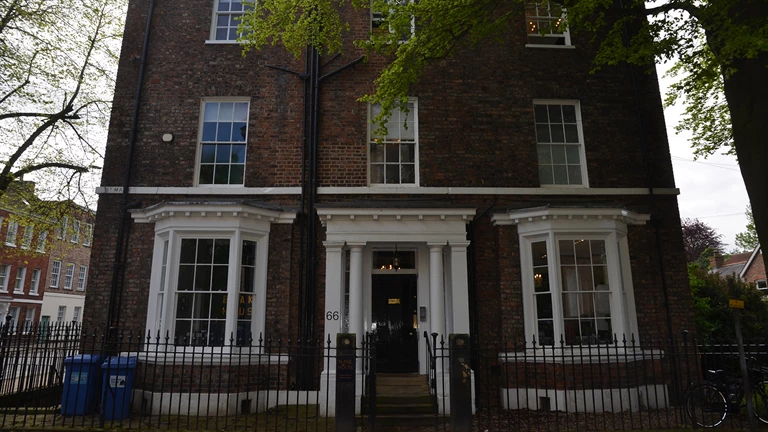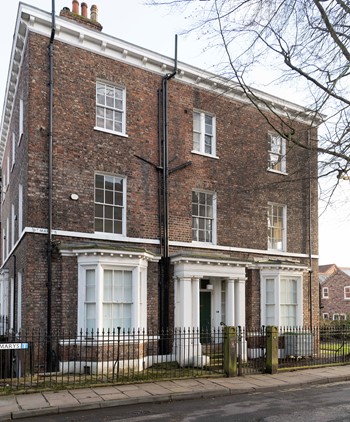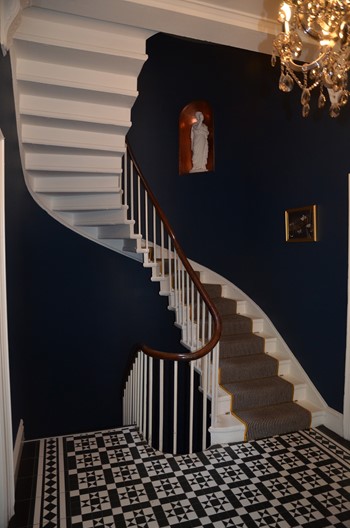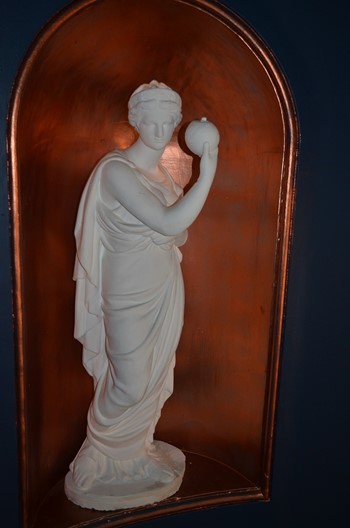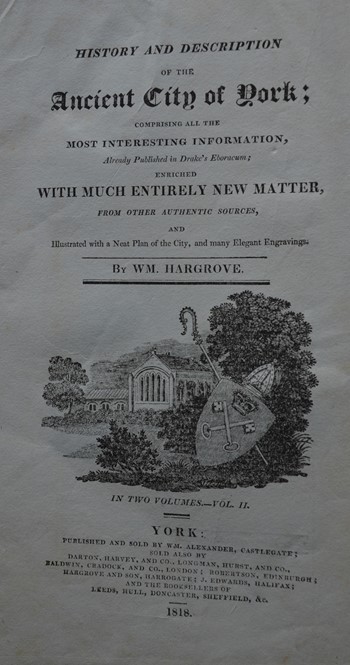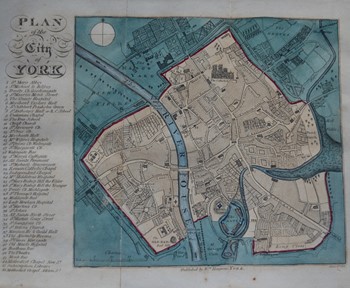66 Bootham
Home to cockfighting, a Greek goddess and The Strangers’ Guide to York.
Wrapped around the corner of Bootham and St Marys, the impressive brick townhouse of no. 66 Bootham, was built between 1851-52 and sits on the site of the Old Cockpit House. As the name suggests, it was a popular venue for cockfighting in the 18th century.
A well-attended gathering place, the location attracted people from a wide social strata, including gentry, farmers, tradesmen and the military. One notorious incident in 1760 involved the York Constables who had prepared lists of those farmers and yeoman from across the East Riding they believed would qualify for service in the York Militia. Word got out and riots ensued. An angry mob entered through Monk Bar and descended on Cockpit House; the indignant and furious rioters determined to find and destroy the lists. Finding the building empty the troublemakers decided to ‘drink the house dry’ and then proceeded to pull the house down. Rebuilt shortly after the incident, the new Cockpit House was eventually demolished in 1850, a year after cockfighting was outlawed in England.
The architect of No.66 (and the adjoining 64) is not known, but some features might suggest the partnership of JB & W Atkinson. The building is built in Brindled brick: a dark coloured material first developed by the London Brick Company and often found on the facades of many of York’s residencies built in the 19th century.
The brickwork is fashioned in a high status Flemish Bond with three storeys, cellars and attics. Surrounded by spear-like railings, those to the right are set in a dwarf wall enclosing a long open garden stretching down along St Marys.
At ground level you’ll find an imposing Grecian-style porch, designed as a distyle-in-antis: an architectural feature where load-bearing antae, or pillars, frame a pair of round columns in imitation of a Greek temple façade. This structure is unique in York architecture and highly appropriate for the first owner William Hargrove (1788-1862). Hargrove was a journalist, newspaper proprietor and historian who came to the city in 1813 to take over the York Herald. He went on to edit this weekly newspaper for the next 35 years and was living at no. 66 Bootham by 1853.
A dedicated antiquarian, Hargrove spent much of his spare time collecting evidence of excavated Roman and medieval occupation. Around the time no. 66 Bootham was being built, Hargrove gave his whole collection of fragments to the Yorkshire Philosophical Society for display in their new museum, in what we know today as Museum Gardens.
Within the porch the four panel front door is flanked by side lights and above the door is a two-pane borrowed light panel. Either side of the entrance you’ll see two large bay windows with large sashes with thin section ‘lamb’s tongue’ glazing bars.
Internally, some of the original fireplaces survive along with the elegant, cantilevered stone staircase rising in a curve to the second floor. The balustrades are square iron rods topped by a shaped wooden handrail and at first floor level a domed niche is the setting for a plaster statue of the Greek goddess Persephone holding a pomegranate in her left hand. She and the seed-filled fruit symbolise regeneration of nature when the abducted goddess was allowed by her husband, Hades, to return to the Earth’s surface for four months every year.
As well as an intense interest in archaeology, Hargrove’s most enduring and important legacy was to write and publish a two-volume history of York in 1818. His original intention had been to reprint Francis Drake’s famous Eboracum published in 1730, but it proved too difficult. As a result he reproduced the body of Drake’s text in volume I and in volume II introduced The Strangers’ Guide to York, possibly the first comprehensive walking guide of the city. Full of observation and description, Hargrove also included a coloured map drawn by Henry Cave in around 1815.
Itself a fascinating historical record, Cave’s map illustrates the layout of York before any major 19th century streetscape interventions. The creation of St. Leonards Place, for example, linking Bootham with Blake Street had not yet been started. The significant development of the Manor Yard for the Yorkshire Philosophical Society had not yet taken place, nor the demolition of the barbicans at Bootham, Micklegate and Monk Bar. There is no sign of the creation of Parliament Street that linked Thursday Market with the markets held in Pavement. Also absent is the advent of the railway at Toft Green and new developments in the ancient Priory Gardens near Micklegate Bar.
In 1842 Hargrove reprised his Strangers’ Guide to York as an illustrated pocket version, which proved to be hugely popular and much copied in later years.
In 1881 the Census lists the occupant as Frederick Sydney Morris and family, a Unitarian Minister at St Saviourgate Chapel. By 1891, and throughout the 20th century, the townhouse was the residence of Professor William Barnby and family. Barnby was Professor of Music at the Wilberforce School for the Blind at King's Manor. The garages were added in the 1930s, replacing earlier outbuildings. In the latter part of the 20th century the building was occupied by a dental practice.
The Trust acquired no. 66 Bootham in 2004 when it became the home of the British Council for Archaeology. Today, the Council have their offices at another Trust building De Grey House, and no. 66 Bootham still serves the people of York, leased to Blake House it is available as work space and serviced offices.
Discover more about no. 66 Bootham
St Mary's House
66 Bootham
York
YO31 7BZ
Historic England Grade ll listed building
Discover more about York’s archaeological heritage and a ground-breaking, world famous dig from another 19th century York antiquarian Charles Wellbeloved who lived at Middleton House.

